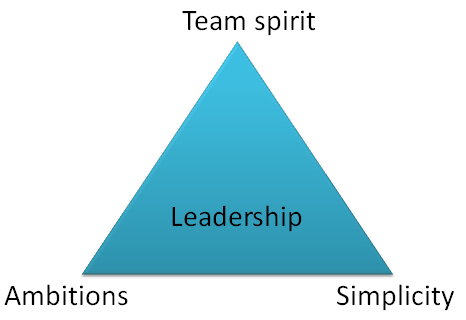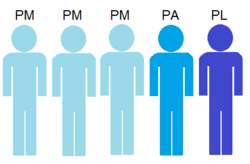Project management within volunteering organisations
Developed by Kristine Maria Clemmensen-Rotne
Within volunteering organizations, leading of projects is being done without the classic authority, that can often be seen in companies. This means that all volunteers have to be motivated by other factors, such as the feeling of purpose or the process of the project. To create a motivational atmosphere it is also important to focus on communication and on involving the volunteers.
The purpose of this article is to illustrate project management practices in volunteering organisations. The Danish scouting and guiding organization, Det Danske Spejderkorps, was drawn upon for references and case examples. The objective of this organization is to create an inspirational environment with possibilities for development of the members.[1] Many volunteering organisations have lost members over the last years. Det Danske Spejderkorps was also loosing members for some years, but has managed to turn this tendency around and has been growing in numbers since 2008.[2] Furthermore the project management practices from volunteering organisations will be discussed with the focus on applicability within companies.
Contents |
Project management without classic authority
Good project management can mean the difference between an organisation in growth or one in regression. A study in 2007 found that; Results indicated significant relationships between management practices and retention problems. [3] It is therefore interesting to study volunteering organisations with growth to find the management practices that are capable of keeping the volunteers motivated.
A study were done in 2006 for Det Danske Spejderkorps on what makes a scout group attractive to be in.[4] Though the study were done specifically on groups[footnotes 1], some of the findings are also true for project groups within scouting. Among the findings that are relevant to volunteering project groups we find a model[footnotes 2] consisting of four factors; Team Spirit, Ambition, Simplicity and Management.[4] These four factors were all present in the well functioning groups and are generally found in well functioning project groups within Det Danske Spejderkorps. The study has shown that none of these factors can be replaced by the others and that leadership is the adhesive binding the others together.
Team Spirit
It is important that the project group see themselves as a team and try to solve their challenges together in stead of separately. The project group has to meet on a regular basis, both in professional and social context. The meetings has to be carried out in a professional and result-oriented way. It is often an advantage if the project group consists of members with different backgrounds[4], this being different geographical locations, different educations, different working experience and different scouting experiences.[footnotes 3]
A way of creating team spirit is through the patrol system used in most scouting organisations. The patrol system is used to teach the scouts to work together when solving problems. The Patrol Leader (see figure 2 for illustration) will often be one of the older and more experienced members. The Patrol Leader will have the last say in decisions and be in charge of the other Patrol Members. The Patrol Leader and the Patrol Assistant will often have a Mentor/Mentee relationship and thereby the system ensures a form of succesion planning. Most of the challenges the scouts will be faced with are designed so it takes most of the patrol to solve the tasks. Also the challenges will usually be rather diverse so the different members of the patrol will have the chance to excel. In scout competitions it is not unusual that there, besides the 1st til 3rd prize, will be a so-called Turn Out prize, which is the prize for the best collaboration. This illustrates that there is a great focus on welcoming everybody in the fellowship and utilising the diversity of the different scouts in the patrol.
Growing up with the patrol system provides a very safe learning environment where it is possible to make mistakes and learn for your self after the Learning by doing[5] and Children leading children[6] principles. For a lot of scouts the principles of the patrol system follow them in their adult life. They wish to make room for diversity and be able to keep learning by doing even though it inevitably will lead to some mistakes.
The organisational culture of accepting mistakes helps in creating a positive culture around failure in project management. This means that the project groups are usually not afraid to think new or to think big. This often leads to unusual projects that both surprise and impress the surroundings. Furthermore the project groups who has made mistakes before, become more aware of how to ensure good solutions to potential problems.
Team spirit can backfire if the team spirit turns in to tribalism. If tribalism occurs the project group is likely to die out, since no new members are taken in when old members leave the group. Tribalism itself might also dissolve the group quicker because the projects are less likely to be innovatiove and challenging, when no new ideas are brought in to the group from the outside.
Ambition
About ambition, it is worth noting that; If your concept of what volunteers can contribute is limited, you will design a volunteering structure that indeed keeps achievement low. But if you are open to the potential of what might develop, you will find ways to encourage volunteers’ success. [7] The good project groups accomplish challenging activities with high standards. The purpose of the project group has to be visible and specific, so the volunteers are striving towards the same goal.[4]
Evaluation of volunteers
Remembering to commend the volunteers and celebrate the victories of the project group is also important. The volunteers need to feel like their effort makes a difference. According to McCurley and Lynch evaluation of the volunteers is an important necessity since most volunteers want to do the best job they can. The absence of feedback and assistance is both demeaning and disturbing to them... Failing to evaluate a volunteer sends a clear message that you don’t care about the quality of the work,and that you don’t care much about the volunteer. Both volunteers who know they aren’t doing well and those who think they should be congratulated for good work will think less of the volunteer effort, and of you, if evaluations are not conducted.
There are two basic reasons for conducting volunteer evaluations:
- 1. To help the volunteers work closer to her/his potential.
- 2. To help the organization[8]
Most adult scouts are very aware of their own flaws due to a big number of self evaluations and evaluations of the patrol effort. They will also be taught to evaluate others in a constructive way, but there is far more emphasis on recieving the evaluation for the sake of personal improvement. The big emphasis on evaluation and reflection on one's personal strenghts and weaknesses can help the project team members make rather good estimates of the difficulty of projects they are joining. This ability is especially used within project teams that split into sub-project teams. Here it is common that members will try to take some of the sub-projects they find easy, while often taking one or two of the sub-projects they specifically know will challenge their abilities. This way the project team members develop more different skills. A rule of thumb for volunteers in Det Danske Spejderkorps is that you do not stay in a certain position for more than 6 years.[9] This ensures that most volunteers take on new responsibilities and keep on developing over the complete span of their time within the organisation.
The risk of too high ambitions are too complicated projects. These might become more fatiguing than motivating for the members of the project group.
Simplicity
The best project groups manage to minimize the fundamental conflict all volunteers will have between the time they need to spend on family, work and their volunteering organisation. It helps to have simple routines and standard procedures when possible. Describing the tasks may also help spread them more among the project team members. If the tasks are transparent and clearly demarcated it makes it easier for volunteers to offer their help or to ask others for help.[4]
The danger of simplicity is when routines are chosen over potential new ways of doing the work. If no new ideas get tested anymore the project group might miss out on ways to improve the work. This could mean the group will miss out on opportunities to higher the ambitions.[4]
Management
As seen in the figure, mangement is the adhesive, that binds the other factors together. Good management is both organisational and visionary. On the organisational side the management has to make certain that tasks are carried out and the meetings are planned and executed in a good way. The visionary part is to help the group see the bigger picture and think further ahead. Good management will make it possible to maintain the good team spirit, to carry out the big ambitions and to create the simplicity to make it easy for the volunteers to contribute.[4]
Pitfalls of management within volunteering project groups is lack of communication. If the volunteers feel that they do not understand the reasons for a specific decision, or that they have not had the chance to be heard in the decision process, they are not always likely to follow their leaders. Another risk is burnouts within management, when the leaders do not manage to ask for help in time. In general it is better if the leader(s) only have the management task, since it is a demanding task. The task of leading is sometimes underestimated among volunteers.[4]
Communication
Establishing a common language within the project team is especially important when working with volunteers. Volunteer work is value based and values are more often felt than thought or articulated. This means that it will be difficult for some volunteers to express the values they feel are central to the organisation they are part of. This problem requires awareness from the project manager. It is important to be aware if the project group members are able to formulate the purpose of the group. Both to be certain every team member knows what they are working for, but also to be certain that everyone is able to question and debate the purpose of the project group. Giving the project group a common language to communicate about the purpose ensures that the purpose can be reconsidered and renewed if needed.
Figure 3 illustrates project team members that are not sharing a common language on a particular subject. They might not be aware that even though they are using the same words, it has completely different meanings to them. This problem might only be realized once the project work has started and problems have already occured.
Involvement
Many volunteers prefer to be involved in the decision making concerning their projects. When the members of a project group are involved in the decision making, it will be easier for them to understand the reasoning behind the choices and thereby accept and live by the decision. When the project members are fully aware of the goal and the strategy to achieve it, they are reassured that they are contributing to the right goal. This therefore provides a better working environment for the volunteers if they take an active part in the decision making concerning the project.
When the volunteers are involved actively in the decision processes, it is possible to demand both seriousness and ambitiousness about the task. Once the project group manages to establish an ambitious and professional team, it will provide a feeling of pride to be part of the team. Team members will therefore strive even harder to deliver well done tasks for the team. When the team feels good about themselves there will also be more room for fun activities in between the more serious activities. This will further support the team spirit of the team.
Involvement goes both ways. A way to motivate the team members is for the project leader to ask how the team members are doing with the tasks. It will provide information about how the tasks are coming along. It will also make it easier for the team member to ask for help if needed and it can provide the feeling of efforts being noticed.
Discussion
The foundation of volunteering organisations is based on making people feel like the "work carries its own reward". Therefore, many of the best practices that are being taught within project management have already been implemented in some volunteering organisations. This happens naturally, since the volunteers will bring the prefered or most meaningful practices with them from work into the organisations they spend their spare time in.
As described above, the volunteering organisations provide a learning environment where it is permitted to take chances and experiment. This makes it possible for new tools and practices to get implemented and tested in the volunteering organisations long before many of the companies will dare to try them.
Since volunteers have to split their time between work, their families and their volunteering organisation, they have to feel like they volunteer time is well spend. This means that many project groups will be very focused on spending their time in the most optimal way. The most optimal way being a mixture of being efficient while still having the feeling of personal development, which can be a more time consuming activity. This makes it possible to study the Human Resource Management within volunteering organisations.
The Company aspect
Volunteering organisations provide insights into different motivational factors that drive its members to actively engage in projects. If the factors that drive volunteers can be used to drive paid employees, then companies will experience employees that do their jobs, not only for the money, but because they love doing what they do. This will make them perform better and have less sick leave. Google for one, has proven the benefits of this concept.[10] Additionally, companies that provide an organisational culture with focus on the development of the employees are likely to be more attractive and will therefore be able to draw in more skilled employees. When the employees have a clear feeling of purpose and feel like the work they do makes a difference, they will automatically be better representatives for the company. Providing a safe learning environment where it is alright to make small mistakes, will allow the employees to take more responsibility and be more innovative. Furthermore the constructive evaluations will allow the employees to learn from both their own and others mistakes. Some knowledge based companies are well on their way with a healthy company culture that allows the employees to contribute fully, but many companies still have a long way to go.
Notes
- ↑ A scout group typically consist of 5 branches, each branch spanding between specific ages, e.g. scouts from 6-8 years old or 12-16 years old. For each branch there will be one or more leaders. There will also typically be a group leader, a treasurer and a board.
- ↑ More different models for retaining volunteers exist, but the model from Det Danske Spejderkorps have been chosen as the reference model for this article, because Det Danske Spejderkorps is an organisation in growth. This would indicate that it is a well functioning model.
- ↑ This will typically be seen in project teams working with educational courses within Det Danske Spejderkorps.
References
- ↑ Formål §3, Lovhæfte 2013-2015, Det Danske Spejderkorps, December 2013
- ↑ De Blå Spejdere oplever medlemsvækst , Arne Simonsen, Nyheder og Analyser, DUF, 11. marts 2009
- ↑ 4-H Youth Development Professionals' Perceptions of the Importance of and Their Current Level of Competence with Selected Volunteer Management Competencies, Ryan J. Schmiesing and R. Dale Safrit, Research in Brief, volume 45, June 2007
- ↑ 4.0 4.1 4.2 4.3 4.4 4.5 4.6 4.7 Den attraktive Spejdergruppe - Medlemsundersøgelse for Det Danske Spejderkorps, Friluftsrådet, 28. juli 2006
- ↑ Fundamental principles - The basic ideas underlying the scout movement, World scout organization of the scout movement, 1992
- ↑ Spejder skal gøre indtryk - Udviklingsplan frem mod 2020, Det Danske Spejderkorps, August 2014
- ↑ From the Top Down: The Executive Role in Successful Volunteer Involvement, Susan J. Ellis, Energize, 3rd edition, 2010
- ↑ Volunteer Management: Mobilizing All the Resources of the Community, Steve McCurley and Rick Lynch, 3rd Edition, INTERPUB GROUP, 2011
- ↑ 6-års princippet, §2 Lovhæfte 2013-2015, Det Danske Spejderkorps, December 2013
- ↑ How employee freedom delivers better business, Susanne Gargiulo, CNN, September 21st 2011


